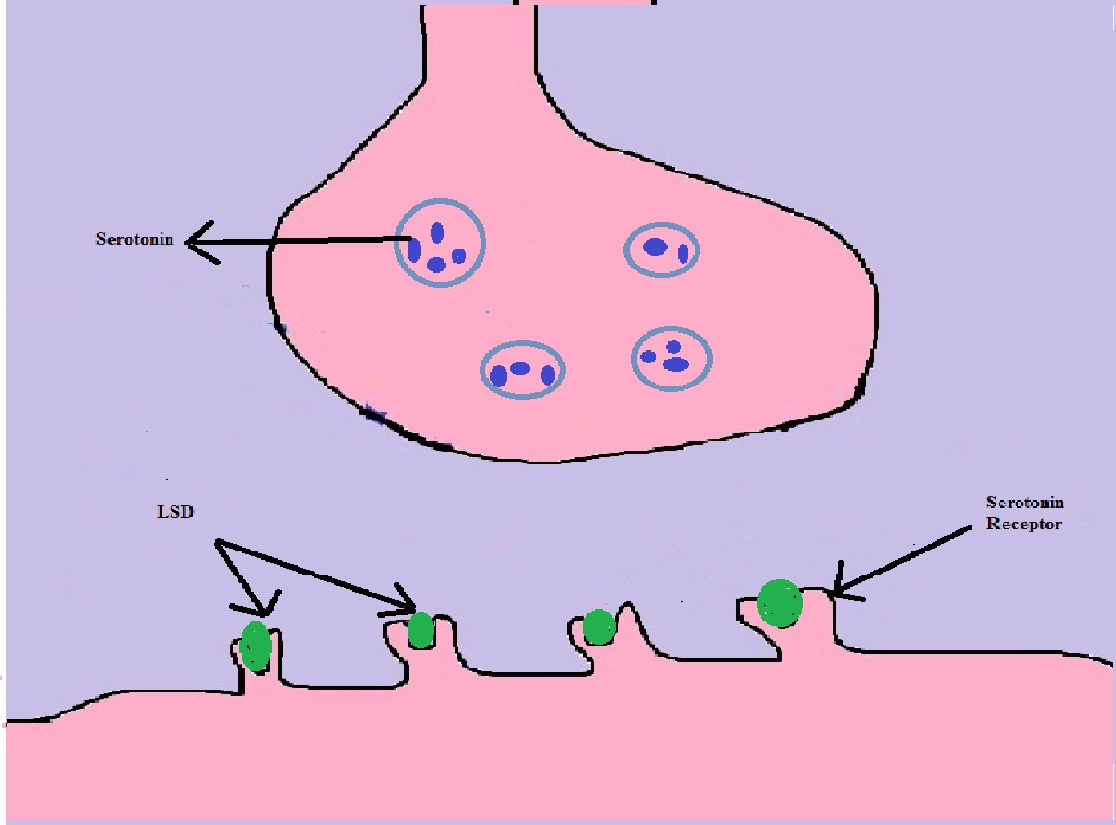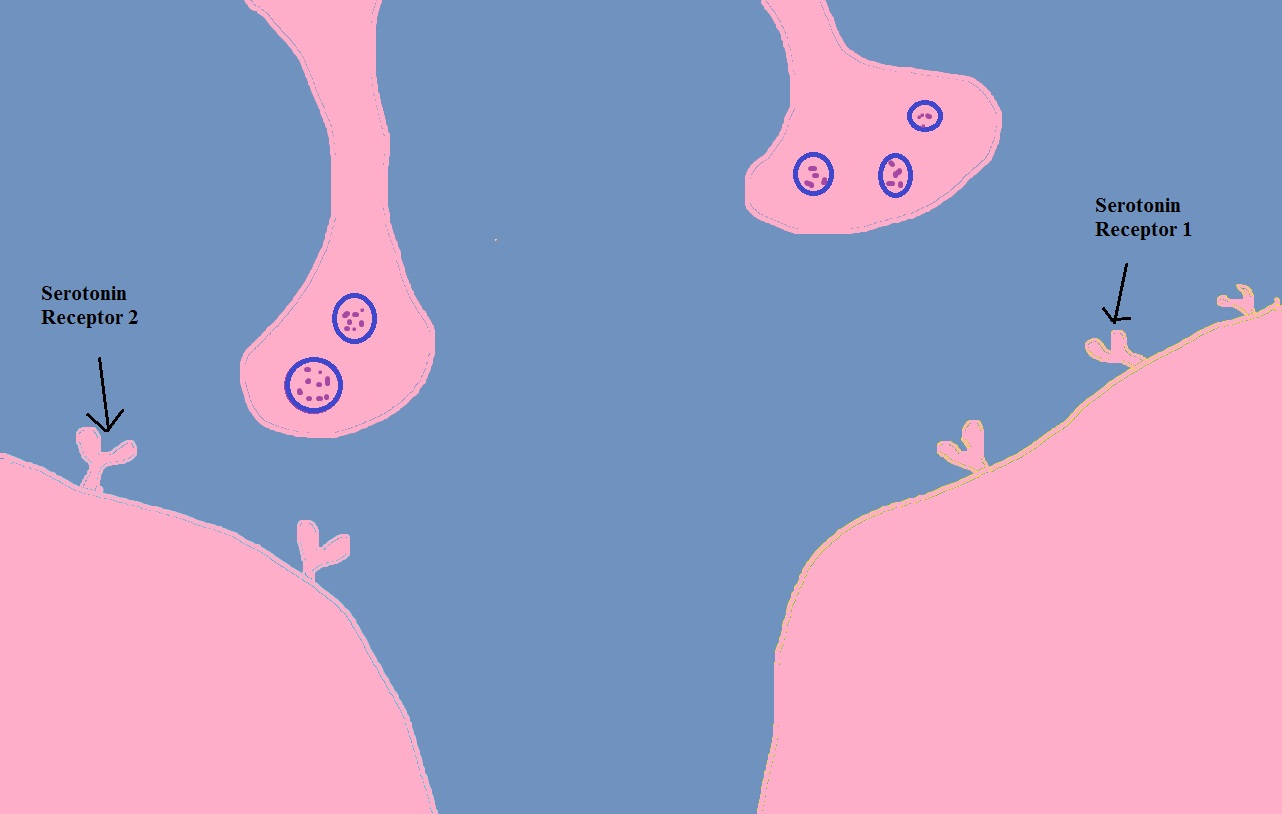Structural Biochemistry/Drug Reward Path In The Brain
Marijuana
[edit | edit source]1) Inhibitory neurotransmitters are active in the synapse before marijuana goes into the system. The job of these neurotransmitters is inhibiting dopamine from being released into the synapse.
2) Cannabinoid receptors shut off the releasing of inhibitory neurotransmitters when activated by the body’s native cannabinoid. Dopamine is released when there is no inhibition.
3)THC, the active chemical in marijuana, mimics anandamide and binds to cannabinoid receptors. The inhibition is shut off and dopamine starts to exit into the synapse.
4)Anandamide is famous for being involved in removing short term memories. It is also responsible for giving the relaxation and calmness feeling and it slows down the movement. Unlike THC, anandamide is very fragile and has a the tendency to break down very quickly in the body. That is why anandamide doesn’t produce perpetual natural “high”.
Cocaine
[edit | edit source]1) Dopamine is taken out of the synaptic cleft by the dopamine transporting molecules after dopamine is done with its job.
2) What cocaine does is blocking the transporters, making dopamine stuck in the synaptic cleft. As a result, dopamine binds to the receptors over and over and that causes overstimulation in the cell.
3) Finally, Cocaine concentrates in the reward pathway of the brain. It also activates the part of the brain that is in control of the voluntary movement. That is why people who abuse the use of cocaine and not able to stay still.
Alcohol
[edit | edit source]1) GABA which is an inhibitory transmitter is active all over the brain. These neurotransmitters control the neural activity in many of brain pathways. The cell is less likely to fire when GABA binds to its receptors.
2) In another area of the brain, Glutamate acts as the brain’s general purpose excitatory neurotransmitter.
 3) Alcohol delivers sedative punch once it goes into the brain. It interacts with GABA receptors and drives them to be more inhibitory. Then, it binds to the glutamate receptors and inhibits glutamate neurotransmitters from binding to their receptor. As a result, the cell is inhibited from being excited.
3) Alcohol delivers sedative punch once it goes into the brain. It interacts with GABA receptors and drives them to be more inhibitory. Then, it binds to the glutamate receptors and inhibits glutamate neurotransmitters from binding to their receptor. As a result, the cell is inhibited from being excited.
 4) Therefore, alcohol affects areas of the brain that are in charge of memory formation and decision making (frontal lobe).
4) Therefore, alcohol affects areas of the brain that are in charge of memory formation and decision making (frontal lobe).
Heroin
[edit | edit source]1) Inhibitory transmitters that are active in the synapse inhibit dopamine neurotransmitters from being released.
2) When natural opioid that are produced by the body (endogenous opioids) activate opioid receptors, inhibitory transmitters release is shut down. When there is no inhibition, dopamine is released and it binds to dopamine receptors.
3) When heroin enters the system, it binds to the opioid receptors because it has the same shape as endogenous opioids. This mechanism turns off dopamine inhibition and dopamine gets released into the synapse. This in turn generates feelings of sedation and well-being.
4) These opioid receptors are connected to neurons that are in charge of the transmission of pain, stress response, and emotional attachment. As a result, drugs that are heroin-like are used as painkillers to sustain pain of a massive injury.
LSD
[edit | edit source]1) LSD drug is exclusive on a neuron called serotonin. LSD shape resembles that of Serotonin and diminish the serotonin effect by binding to its receptor.
2) There are many kinds of serotonin receptors in the brain and each is responsible for a specific function.
3) LSD binds to certain receptors but not in the same way usually. LSD can inhibit or excite these receptors. This is why LSD has complex sensory effects.
4) LSD is just like other hallucinogens, they excite a certain region in the brain called locus coeruleus. In this area, there is a neuron attached to it that branches to different sensory areas in the brain. Locus coeruleus is in charge of feelings like wakefulness and illicitness response to unexpected stimuli.
Meth
[edit | edit source]1) Dopamine is removed from the synaptic cleft using dopamine transporters. Meth is taken into the cell because meth mimics the shape of dopamine and the dopamine transporters does not recognize the dopamine from meth.
2) When meth is transported to the inside of the cell, it enters the vesicle that carries dopamine and forces the dopamine out of the vesicle.
3) The dopamine gets pumped out of the cell into the synaptic cleft when dopamine is abundant inside the cell by the reverse pumping of the dopamine transporters.
4) Once the dopamine is outside of the cell, it binds to the dopamine receptors again and again because it is abundant in synaptic cleft.
5) Meth works directly on the brain’s reward pathway. Therefore, it is highly addictive and meth users feel intense pleasure when they take it.
Ecstasy
[edit | edit source]1) Serotonin is removed from the synaptic cleft by serotonin transporters after they have done their job.
2) Serotonin transporters pick up ecstasy because ecstasy mimics the shape of serotonin. Actually, serotonin transporters have a higher affinity to ecstasy than serotonin molecules themselves.
3) The interaction of serotonin transporters with ecstasy confuses the transporters in a way that they start pumping serotonin out of the cell into the synaptic cleft.
4) Because serotonin becomes abundant in the synaptic cleft, it starts binding to receptors over and over causing overstimulation to the cell.
5) Ecstasy has an effect on sleep, mood, perception, and appetite. It also has an indirect effect on reward pathway. Ecstasy is not as addictive as other drugs because it has a milder release of dopamine along the reward pathway.



















